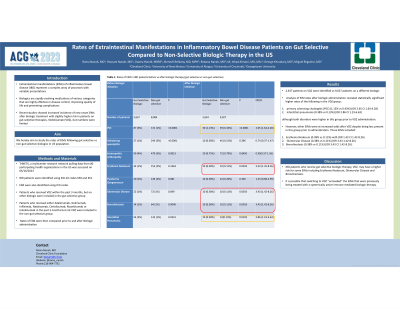Tuesday Poster Session
Category: IBD
P3591 - Rates of Extraintestinal Manifestations in Inflammatory Bowel Disease Patients on Gut Selective Compared to Non-Selective Biologic Therapy in the US
Tuesday, October 24, 2023
10:30 AM - 4:00 PM PT
Location: Exhibit Hall


Rama Nanah, MD
Cleveland Clinic
Cleveland, OH
Presenting Author(s)
Rama Nanah, MD1, M Housam Nanah, MD1, Osama Hamid, MBBS1, Ahmed Eltelbany, MD, MPH1, Robana Nanah, MD2, Jehad Almasri, MD, MSc3, George Khoudary, MD4, Miguel Regueiro, MD5
1Cleveland Clinic, Cleveland, OH; 2University of Aleppo, Cleveland, OH; 3University of Cincinnati, Cincinnati, OH; 4Georgetown University, Washington, DC; 5Cleveland Clinic Lerner College of Medicine, Case Western Reserve University, Cleveland, OH
Introduction: Extraintestinal manifestations (EIMs) of inflammatory bowel disease (IBD) represent a complex array of processes with variable presentations. Biologics are rapidly evolving medications of various categories that are highly effective in disease control, improving quality of life and preventing complications. Recent studies showed increased incidence of new onset EIMs after biologic treatment with slightly higher risk in patients on gut-selective therapies, Vedolizumab (VDZ), but numbers were limited. We hereby aim to study the rates of EIMs following gut selective vs non-gut selective biologics In US population.
Methods: TriNETX, a multicenter research network pulling data from 80 participating health organizations in the US was accessed on 05/16/2023. IBD patients were identified using ICD-10 codes K50 and K51. EIM were also identified using ICD codes. Patients who received VDZ within the past 3 months, but no other biologic were included in the gut-selective group. Patients who received either Adalimumab, Golimumab, Infliximab, Natalizumab, Certolizumab, Rizankitumab or Ustekinumab in the past 3 months but not VDZ were included in the non-gut selective group. Rates of EIM were then compared prior to and after Biologic administration.
Results: 2,637 patients on VDZ were identified vs 9,027 patients on a different biologic. Analysis of EIM rates after biologic administration revealed statistically significant higher rates of primary sclerosing cholangitis (PSC) (1.13% vs 0.43%) (OR 2.65 CI 1.64-4.28) and Interstitial pneumonia (0.38% vs 0.13%) (OR 2.86 CI 1.23-6.63) in the VDZ group although both disorders were higher in this group prior to VDZ administration. However, other EIMs were at increased odds after VDZ despite being less present in this group prior to administration. These EIMs included: Erythema Nodosum (0.38% vs 0.11%) with (OR 1.43 CI 1.42-8.26), Glomerular Disease (0.38% vs 0.11%) (OR 3.43 1.42-8.26) and Bronchiectasis (0.38% vs 0.11%) (OR 3.43 CI 1.42-8.26).
Discussion: IBD patients who receive gut selective biologic therapy, VDZ, may have a higher risk for some EIMs including Erythema Nodosum, Glomerular Disease and Bronchiectasis. It is possible that switching to VDZ “unmasked” the EIMs that were previously being treated with a systemically active immune mediated biologic therapy.
Disclosures:
Rama Nanah, MD1, M Housam Nanah, MD1, Osama Hamid, MBBS1, Ahmed Eltelbany, MD, MPH1, Robana Nanah, MD2, Jehad Almasri, MD, MSc3, George Khoudary, MD4, Miguel Regueiro, MD5. P3591 - Rates of Extraintestinal Manifestations in Inflammatory Bowel Disease Patients on Gut Selective Compared to Non-Selective Biologic Therapy in the US, ACG 2023 Annual Scientific Meeting Abstracts. Vancouver, BC, Canada: American College of Gastroenterology.
1Cleveland Clinic, Cleveland, OH; 2University of Aleppo, Cleveland, OH; 3University of Cincinnati, Cincinnati, OH; 4Georgetown University, Washington, DC; 5Cleveland Clinic Lerner College of Medicine, Case Western Reserve University, Cleveland, OH
Introduction: Extraintestinal manifestations (EIMs) of inflammatory bowel disease (IBD) represent a complex array of processes with variable presentations. Biologics are rapidly evolving medications of various categories that are highly effective in disease control, improving quality of life and preventing complications. Recent studies showed increased incidence of new onset EIMs after biologic treatment with slightly higher risk in patients on gut-selective therapies, Vedolizumab (VDZ), but numbers were limited. We hereby aim to study the rates of EIMs following gut selective vs non-gut selective biologics In US population.
Methods: TriNETX, a multicenter research network pulling data from 80 participating health organizations in the US was accessed on 05/16/2023. IBD patients were identified using ICD-10 codes K50 and K51. EIM were also identified using ICD codes. Patients who received VDZ within the past 3 months, but no other biologic were included in the gut-selective group. Patients who received either Adalimumab, Golimumab, Infliximab, Natalizumab, Certolizumab, Rizankitumab or Ustekinumab in the past 3 months but not VDZ were included in the non-gut selective group. Rates of EIM were then compared prior to and after Biologic administration.
Results: 2,637 patients on VDZ were identified vs 9,027 patients on a different biologic. Analysis of EIM rates after biologic administration revealed statistically significant higher rates of primary sclerosing cholangitis (PSC) (1.13% vs 0.43%) (OR 2.65 CI 1.64-4.28) and Interstitial pneumonia (0.38% vs 0.13%) (OR 2.86 CI 1.23-6.63) in the VDZ group although both disorders were higher in this group prior to VDZ administration. However, other EIMs were at increased odds after VDZ despite being less present in this group prior to administration. These EIMs included: Erythema Nodosum (0.38% vs 0.11%) with (OR 1.43 CI 1.42-8.26), Glomerular Disease (0.38% vs 0.11%) (OR 3.43 1.42-8.26) and Bronchiectasis (0.38% vs 0.11%) (OR 3.43 CI 1.42-8.26).
Discussion: IBD patients who receive gut selective biologic therapy, VDZ, may have a higher risk for some EIMs including Erythema Nodosum, Glomerular Disease and Bronchiectasis. It is possible that switching to VDZ “unmasked” the EIMs that were previously being treated with a systemically active immune mediated biologic therapy.
Disclosures:
Rama Nanah indicated no relevant financial relationships.
M Housam Nanah indicated no relevant financial relationships.
Osama Hamid indicated no relevant financial relationships.
Ahmed Eltelbany indicated no relevant financial relationships.
Robana Nanah indicated no relevant financial relationships.
Jehad Almasri indicated no relevant financial relationships.
George Khoudary indicated no relevant financial relationships.
Miguel Regueiro: AbbVie – Advisory Committee/Board Member, Consultant, Unrestricted educational grants. Alfasigma – Advisory Committee/Board Member, Consultant. Allergan – Advisory Committee/Board Member, Consultant. Amgen – Advisory Committee/Board Member, Consultant. Bristol Myers Squibb – Advisory Committee/Board Member, Consultant, Unrestricted educational grants. Celgene – Advisory Committee/Board Member, Consultant, Unrestricted educational grants. Eli Lilly – Advisory Committee/Board Member, Consultant. Genentech – Advisory Committee/Board Member, Consultant, Unrestricted educational grants. Gilead Sciences – Advisory Committee/Board Member, Consultant, Unrestricted educational grants. Janssen – Advisory Committee/Board Member, Consultant, Unrestricted educational grants. Miraca Labs – Advisory Committee/Board Member, Consultant. Pfizer Inc – Advisory Committee/Board Member, Consultant, Unrestricted educational grants. Prometheus – Advisory Committee/Board Member, Consultant. Salix – Advisory Committee/Board Member, Consultant. Seres – Advisory Committee/Board Member, Consultant. Takeda – Advisory Committee/Board Member, Consultant, Unrestricted educational grants. Target RWE – Advisory Committee/Board Member, Consultant. UCB – Advisory Committee/Board Member, Consultant, Unrestricted educational grants. Wolters Kluwer Health – Royalties.
Rama Nanah, MD1, M Housam Nanah, MD1, Osama Hamid, MBBS1, Ahmed Eltelbany, MD, MPH1, Robana Nanah, MD2, Jehad Almasri, MD, MSc3, George Khoudary, MD4, Miguel Regueiro, MD5. P3591 - Rates of Extraintestinal Manifestations in Inflammatory Bowel Disease Patients on Gut Selective Compared to Non-Selective Biologic Therapy in the US, ACG 2023 Annual Scientific Meeting Abstracts. Vancouver, BC, Canada: American College of Gastroenterology.
